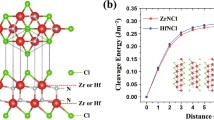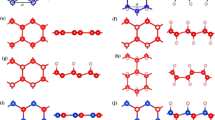Abstract
Context
This paper systematically analyzes the phonon dispersion curves of single-layer ZrS2, ZrSe2, and ZrS2/ZrSe2 heterostructures under different strains. The phonon spectra and thermal parameters of the three structures were obtained based on the density functional perturbation theory method. The upper limits of strain that different monolayers and heterojunctions can withstand were studied. The monolayers ZrSe2 and ZrS2 can withstand up to 8% biaxial tensile strain, and the ZrS2/ZrSe2 heterojunction can withstand up to 6% biaxial tensile strain. In addition, the van der Waals force of the heterojunction may cause phonon tearing in the vertical direction. The application of biaxial tensile strain can adjust the thermal properties of the system to a large extent, which is similar to the strain effect in the pristine case. When the temperature rises, the entropy enthalpy of the three structures also gradually increases, the free energy gradually decreases, and the heat capacity of the system gradually increases until it tends to be stable. Taking single-layer ZrS2 as an example, we analyzed the change curve of thermal properties of single-layer ZrS2 under tensile strain. The results show that with the gradual increase of strain, the crystal’s entropy, enthalpy, and free energy change differently. In addition, the heat capacity increases slowly under high temperatures. When all systems reach the limit strain, the phonon spectrum appears to have an imaginary frequency, and the thermal properties decrease significantly.
Methods
This paper uses the first-principle calculation method based on density functional theory, and the PBE exchange–correlation function based on generalized gradient approximation (GGA) is selected for a specific calculation. The density functional perturbation theory (DFPT) calculates the full kinetic matrix. Because the lattice constants of ZrS2 and ZrSe2 are similar and have similar periodicity, the corresponding unit cells are used for structural optimization and property calculation. The Brillouin zone is integrated using the K points generated by the Monkhorst–pack method. For single-layers ZrS2 and ZrSe2, 8 × 8 × 1 K-point grid is selected, and for ZrS2/ZrSe2 heterojunction, 8 × 8 × 2 K-point grid is selected. A vacuum layer of 30 Å was added in the vertical direction to avoid interlayer interaction. The non-conservative pseudopotential method is used to optimize the structure, and the optimization convergence is set as follows: the cutoff energy is set to 700 eV, the convergence threshold of the maximum force between atoms is 0.01 eV/Å, the convergence threshold of the maximum energy change is set to 1 × 10–9 eV, and the convergence threshold of the maximum displacement is 0.001 Å.







Similar content being viewed by others
Data availability
No datasets were generated or analyzed during the current study.
References
Edwards RS, Coleman KS (2013) Graphene synthesis: relationship to applications. Nanoscale 5:38–51
Xu T et al (2022) Advances in synthesis and applications of boron nitride nanotubes: a review. Chem Eng J 431:134118
Mak KF, Lee C, Hone J, Shan J, Heinz TF (2010) Atomically thin MoS 2: a new direct-gap semiconductor. Phys Rev Lett 105:136805
Li Y, Kang J, Li J (2014) Indirect-to-direct band gap transition of the ZrS 2 monolayer by strain: first-principles calculations. RSC Adv 4:7396–7401
Gao Y, Zhao X, Wang H, Wang T, Wei S (2018) Electronic and magnetic properties of structural defects in pristine ZrSe2 monolayer. Comput Mater Sci 146:36–41
Huang H et al (2020) The chemistry and promising applications of graphene and porous graphene materials. Adv Func Mater 30:1909035
Xin Q et al (2017) Electronic structure in 1T-ZrS2 monolayer by strain. Physica E 93:87–91
Zhen Y-X et al (2017) Ultrahigh power factors in P-type 1T-ZrX2 (X= S, Se) single layers. Sci bull 62:1530–1537
Wei X, Yang L, Bao J (2023) Effect of non-metallic doping and tensile strain on photoelectric properties of 1T-ZrS2 monolayer. Russ J Phys Chem A 97:2501–2509
Song Q et al (2022) Strain-tuned mechanical, electronic, and optoelectronic properties of two-dimensional transition metal sulfides ZrS(2): a first-principles study. J Mol Model 28:63. https://doi.org/10.1007/s00894-022-05052-8
Mañas-Valero S, García-López V, Cantarero A, Galbiati M (2016) Raman spectra of ZrS2 and ZrSe2 from bulk to atomically thin layers. Appl Sci 6:264
Abdulsalam M, Rugut E, Joubert D (2020) Mechanical, thermal and thermoelectric properties of MX2 (M= Zr, Hf; X= S, Se). Materials Today Communications 25:101434
Ding G, Gao G, Huang Z, Zhang W, Yao K (2016) Thermoelectric properties of monolayer MSe2 (M= Zr, Hf): low lattice thermal conductivity and a promising figure of merit. Nanotechnology 27:375703
Zhen YX et al (2017) Ultrahigh power factors in P-type 1T-ZrX(2) (X = S, Se) single layers. Sci Bull (Beijing) 62:1530–1537. https://doi.org/10.1016/j.scib.2017.10.022
Qin D, Ge X-J, Ding G-Q, Gao G-Y, Lü J-T (2017) Strain-induced thermoelectric performance enhancement of monolayer ZrSe2. RSC Adv 7:47243–47250. https://doi.org/10.1039/c7ra08828k
Wang D, Yang L, Cao J (2021) Thermal properties of monolayer MoS2 and WS2/MoS2 heterojunction under three strain states. Chem Phys 549:111260
Bafekry A, Stampfl C, Ghergherehchi M (2020) Strain, electric-field and functionalization induced widely tunable electronic properties in MoS2/BC3,/C3N and/van der Waals heterostructures. Nanotechnology 31:295202
Obeid MM, Bafekry A, Rehman SU, Nguyen CV (2020) A type-II GaSe/HfS2 van der Waals heterostructure as promising photocatalyst with high carrier mobility. Appl Surf Sci 534:147607
Bafekry A, Yagmurcukardes M, Akgenç B, Ghergherehchi M, Van der Nguyen CV (2020) Waals heterostructures of MoS2 and Janus MoSSe monolayers on graphitic boron-carbon-nitride (BC3, C3N, C3N4 and C4N3) nanosheets: a first-principles study. J Phys D Appl Phys 53:355106
Bafekry A, Neek-Amal M (2020) Tuning the electronic properties of graphene–graphitic carbon nitride heterostructures and heterojunctions by using an electric field. Phys Rev B 101:085417
Bafekry A, Akgenç B, Shayesteh SF, Mortazavi B (2020) Tunable electronic and magnetic properties of graphene/carbon-nitride van der Waals heterostructures. Appl Surf Sci 505:144450
Zhang Y, Duan L, Fan J-B, Ni L (2022) Effects of the in-plane uniaxial and biaxial strains on the structural and electronic properties of the monolayer ZrS2: a first-principles investigation. Thin Solid Films 755:139343
Rasmussen FA, Thygesen KS (2015) Computational 2D materials database: electronic structure of transition-metal dichalcogenides and oxides. J Phys Chem C 119:13169–13183. https://doi.org/10.1021/acs.jpcc.5b02950
Chen P, Zhang L, Wang R, Shang J, Zhang S (2019) Electronic and optical properties of the ZrS2/HfSe2 van der Waals heterobilayer with native type-II band alignment. Chem Phys Lett 734:136703
Wang X, Du J, Wei S (2017) Impurity characteristics of group V and VII element-doped two-dimensional ZrSe2 monolayer. Physica E 93:279–283. https://doi.org/10.1016/j.physe.2017.06.032
Vu TV et al (2019) Electronic and optical properties of Janus ZrSSe by density functional theory. RSC Adv 9:41058–41065. https://doi.org/10.1039/c9ra08605f
Baroni S, De Gironcoli S, Dal Corso A, Giannozzi P (2001) Phonons and related crystal properties from density-functional perturbation theory. Rev Mod Phys 73:515
Molina-Sanchez A, Wirtz L (2011) Phonons in single-layer and few-layer MoS 2 and WS 2. Phys Rev B 84:155413
Abrashev M et al (1999) Comparative study of optical phonons in the rhombohedrally distorted perovskites LaAlO 3 and LaMnO 3. Phys Rev B 59:4146
Mooradian A, Wright G (1966) Observation of the interaction of plasmons with longitudinal optical phonons in GaAs. Phys Rev Lett 16:999
Wei L, Liu G-L, Fan D-Z, Zhang G-Y (2018) Density functional theory study on the electronic structure and optical properties of S absorbed graphene. Physica B 545:99–106
Zeyher R (1974) Calculation of resonant second-order Raman efficiencies for allowed and forbidden scattering. Phys Rev B 9:4439
Kampfrath T, Perfetti L, Schapper F, Frischkorn C, Wolf M (2005) Strongly coupled optical phonons in the ultrafast dynamics of the electronic energy and current relaxation in graphite. Phys Rev Lett 95:187403
Glebko N, Karttunen AJ (2019) Lattice thermal conductivity of TiS 2, ZrS 2, and HfS 2: periodic trends studied by dispersion-corrected hybrid density functional methods. Phys Rev B 100:024301
Author information
Authors and Affiliations
Contributions
Yanshen Zhao: writing—original draft, conceptualization, methodology. Lu Yang: supervision, validation. Shihang Sun and Xingbin Wei: visualization, data curation. Huaidong Liu: prepared figures.
Corresponding author
Ethics declarations
Competing interests
The authors declare no competing interests.
Additional information
Publisher's Note
Springer Nature remains neutral with regard to jurisdictional claims in published maps and institutional affiliations.
Foundation: National Natural Science Foundation of China (Approval No: 11102118); Liaoning Province “Millions of Talents Project” Fund (Approval No: 100010131).
Rights and permissions
Springer Nature or its licensor (e.g. a society or other partner) holds exclusive rights to this article under a publishing agreement with the author(s) or other rightsholder(s); author self-archiving of the accepted manuscript version of this article is solely governed by the terms of such publishing agreement and applicable law.
About this article
Cite this article
Zhao, Y., Yang, L., Liu, H. et al. Strain-induced modification in thermal properties of monolayer 1 T-ZrS2 and ZrS2/ZrSe2 heterojunction. J Mol Model 30, 95 (2024). https://doi.org/10.1007/s00894-024-05894-4
Received:
Accepted:
Published:
DOI: https://doi.org/10.1007/s00894-024-05894-4




